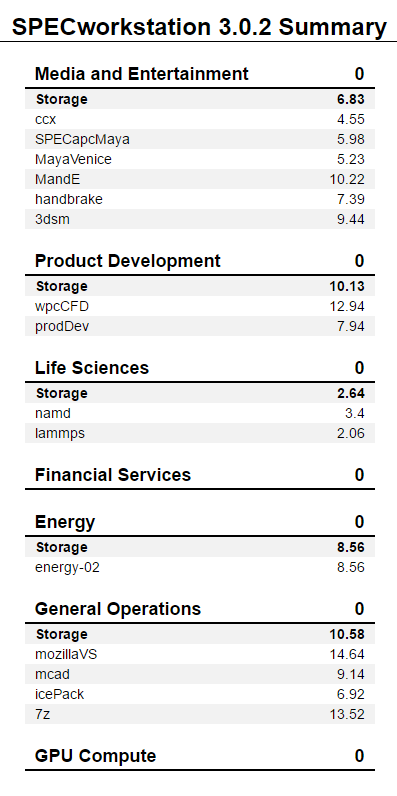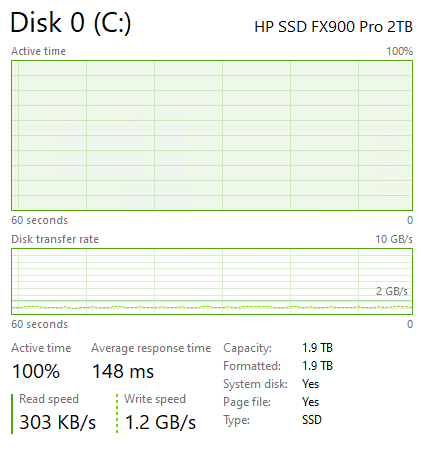SPECworkstation 3.0.2 Storage Benchmark
SPECworkstation benchmark is an excellent benchmark to test systems using workstation-type workloads. In this test, we only ran the Storage component, which is fifteen separate tests.


In my recent SK hynix Platinum P41 review, I essentially considered that drive to be the king of SPECworkstation. Well, that reign did not last long; while the P41 manages to hold onto the top Product Development score and thus is listed at the top of our chart, the FX900 Pro nearly ties it in Product Development and then blows it away in every other test. If SPEC performance is what you care about, the FX900 Pro is king.
Sustained Write Performance
This is not necessarily a benchmark, so much as trying to catch the post-cache write speed of the drive. While I am filling the drive with data to the 85% mark with 10 simultaneous write threads, I monitor the drive for the write performance to dip to the lowest steady point and grab a screenshot.


The Post-cache write speed on the HP FX900 Pro is good at around 1.2 GB/s, putting it in a virtual tie with the WD SN850.
Temperatures
We monitored the idle and maximum temperature during testing with HWMonitor to get some idea of the thermal performance and requirements of the drive. Please keep in mind that our test bench is an open-frame chassis in a 22C room, but with no direct airflow. As a result, this is not representative of a cramped low airflow case and is instead intended to model the temperatures of a drive ‘on its own’.

The FX900 Pro has that strange “graphene thermal pad” and even after testing, I am not sure whether it is helping or hurting. With the pad on, when idling the FX900 Pro sits at 50C, but then under load, the temperatures top out around 82C. With the pad off, idle temps drop to the mid-30s, but load temperatures rise faster and higher. On the upside, this pad is easily removed and you can attach a motherboard or aftermarket heatsink if needed. Under light load, I believe the FX900 Pro will be fine on its own with just the pad, but under heavier use, it will need some kind of active cooling or a real heatsink to keep temperatures down.
Final Words
Today the HP FX900 Pro 2TB is $250 online. That price point is near the lower end of high-performance drives like the WD Black SN850 and the FireCuda 530. Performance on the FX900 Pro is very good, so coming in with relatively low pricing is a good point in the HP drive’s favor. The XPG Gammix S70 2TB still manages a value win though since it is only $200.

The HP FX900 Pro 2TB is great! While I am still a bit confused about the thermal pad and think it is a bit silly, it does not seem to harm the drive in any way. This drive is cheaper than many (but not all) of the other top contenders in the 2TB drive space, and performance remained very high in all of my testing. If you need a high-end 2TB SSD, the HP FX900 Pro 2TB is one to consider.




Who is the component supplier for this HP product?
If the drive hits 82C it is definitely thermal throttling. Not sure if your test bench varies during the tests for speed vs thermals but you can’t compare the speed of if it’s thermal throttling and the other drives aren’t. For thermal tests sure, but if that same setup is used for transfer rate tests you have a bad system. Throw a little water loop with one of the Corsair m.2 water blocks on it so you can get good comparisons on all your drive speed tests.
Any drive that hits thermal limits during testing gets active cooling so that benchmarks are not affected by thermals.
SEQUENTIAL READ MEANS NOTHING FOR NVME.
Strongly disagree Wildcard. When you have 25GbE 40GbE or faster, it is easy to need NVMe sequential read speed limits. That’s easy.
Headbrother: Designed, built & sold under HP Official License by BIWIN.
It seems some of these drives have a high failure rate. The amazon comments hint at this, and I just experienced it myself. Have you seen anything similar reported?